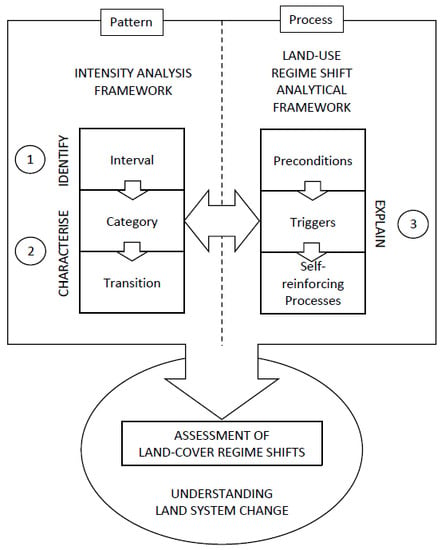Integrating Analytical Frameworks to Investigate Land-Cover Regime Shifts in Dynamic Landscapes
Abstract
1. Introduction
2. Conceptual/Methodological Framework
3. Materials and Methods
3.1. Study Area
3.2. Data Preparation
3.3. Data Analysis
4. Results
4.1. Identifying the Occurrence of the Land-Cover Regime Shift
4.2. Characterising the Dynamics of the Land-Cover Regime Shift
4.3. Explaining the Preconditions, Triggers, and Self-Reinforcing Processes of the Land-Cover Regime Shift
4.3.1. Preconditions
4.3.2. Triggers
4.3.3. Self-Reinforcing Processes
5. Discussion
5.1. Systematic Investigation of Land-Cover Regime Shifts using Complementary Analytical Frameworks
5.2. Resolution is Crucial but Is a Double-Edged Sword
5.3. Historical and Possible Future Drivers of Land-Cover Regime Shifts in Tanintharyi
6. Conclusions and Recommendations
Supplementary Materials
Author Contributions
Funding
Acknowledgments
Conflicts of Interest
References
- Crutzen, P.J. Geology of mankind. Nature 2002, 415, 23. [Google Scholar] [CrossRef] [PubMed]
- Foley, J.A.; DeFries, R.; Asner, G.P.; Barford, C.; Bonan, G.; Carpenter, S.R.; Chapin, F.S.; Coe, M.T.; Daily, G.C.; Gibbs, H.K.; et al. Global consequences of land use. Science 2005, 309, 570–574. [Google Scholar] [CrossRef] [PubMed]
- Vitousek, P.M.; Mooney, H.A.; Lubchenco, J.; Melillo, J.M. Human domination of Earth’s ecosystems. Science 1997, 277, 494–499. [Google Scholar] [CrossRef]
- DeFries, R.S.; Foley, J.A.; Asner, G.P. Land-use choices: Balancing human needs and ecosystem function. Front. Ecol. Environ. 2004, 2, 249–257. [Google Scholar] [CrossRef]
- Verburg, P.H.; Crossman, N.; Ellis, E.C.; Heinimann, A.; Hostert, P.; Mertz, O.; Nagendra, H.; Sikor, T.; Erb, K.-H.; Golubiewski, N.; et al. Land system science and sustainable development of the earth system: A global land project perspective. Anthropocene 2015, 12, 29–41. [Google Scholar] [CrossRef]
- Verburg, P.H.; Erb, K.-H.; Mertz, O.; Espindola, G. Land System Science: Between global challenges and local realities. Curr. Opin. Environ. Sustain. 2013, 5, 433–437. [Google Scholar] [CrossRef] [PubMed]
- Dearing, J.; Braimoh, A.; Reenberg, A.; Turner, B.; van der Leeuw, S. Complex land systems: The need for long time perspectives to assess their future. Ecol. Soc. 2010, 15, 21. [Google Scholar] [CrossRef]
- Müller, D.; Sun, Z.; Vongvisouk, T.; Pflugmacher, D.; Xu, J.; Mertz, O. Regime shifts limit the predictability of land-system change. Glob. Environ. Chang. 2014, 28, 75–83. [Google Scholar] [CrossRef]
- Veldkamp, A.; Lambin, E.F. Predicting land-use change. Agric. Ecosyst. Environ. 2001, 85, 1–6. [Google Scholar] [CrossRef]
- Biggs, R.; Carpenter, S.R.; Brock, W.A. Turning back from the brink: Detecting an impending regime shift in time to avert it. Proc. Natl. Acad. Sci. USA 2009, 106, 826–831. [Google Scholar] [CrossRef]
- Scheffer, M. Critical Transitions in Nature and Society; Princeton University Press: Princeton, NJ, USA, 2009; ISBN 978-0-691-12204-5. [Google Scholar]
- Scheffer, M.; Carpenter, S.; Foley, J.A.; Folke, C.; Walker, B. Catastrophic shifts in ecosystems. Nature 2001, 413, 591–596. [Google Scholar] [CrossRef] [PubMed]
- Lambin, E.F.; Meyfroidt, P. Land use transitions: Socio-ecological feedback versus socio-economic change. Land Use Policy 2010, 27, 108–118. [Google Scholar] [CrossRef]
- Ramankutty, N.; Coomes, O. Land-use regime shifts: An analytical framework and agenda for future land-use research. Ecol. Soc. 2016, 21. [Google Scholar] [CrossRef]
- Zaehringer, J.G.; Llopis, J.C.; Latthachack, P.; Thein, T.T.; Heinimann, A. A novel participatory and remote-sensing-based approach to mapping annual land use change on forest frontiers in Laos, Myanmar, and Madagascar. J. Land Use Sci. 2018, 13, 16–31. [Google Scholar] [CrossRef]
- Sun, Z.; Müller, D. Understanding regime shift in land systems with system dynamics. In Proceedings of the International Congress on Environmental Modelling and Software; Ames, D.P., Quinn, N.W.T., Rizzoli, A.E., Eds.; San Diego, CA, USA, 2014. Available online: https://scholarsarchive.byu.edu/iemssconference/2014/Stream-H/83/ (accessed on 21 February 2019).
- European Environment Agency CORINE Land Cover. Available online: https://www.eea.europa.eu/publications/COR0-landcover (accessed on 20 February 2019).
- Feranec, J.; Jaffrain, G.; Soukup, T.; Hazeu, G. Determining changes and flows in European landscapes 1990–2000 using CORINE land cover data. Appl. Geogr. 2010, 30, 19–35. [Google Scholar] [CrossRef]
- Song, X.-P.; Hansen, M.C.; Stehman, S.V.; Potapov, P.V.; Tyukavina, A.; Vermote, E.F.; Townshend, J.R. Global land change from 1982 to 2016. Nature 2018, 560, 639. [Google Scholar] [CrossRef] [PubMed]
- Aldwaik, S.Z.; Pontius, R.G. Intensity analysis to unify measurements of size and stationarity of land changes by interval, category, and transition. Landsc. Urban Plan. 2012, 106, 103–114. [Google Scholar] [CrossRef]
- Connette, G.; Oswald, P.; Songer, M.; Leimgruber, P. Mapping distinct forest types improves overall forest identification based on multi-spectral Landsat imagery for Myanmar’s Tanintharyi Region. Remote Sens. 2016, 8, 882. [Google Scholar] [CrossRef]
- Rao, M.; Htun, S.; Platt, S.G.; Tizard, R.; Poole, C.; Myint, T.; Watson, J.E.M. Biodiversity conservation in a changing climate: A review of threats and implications for conservation planning in Myanmar. Ambio 2013, 42, 789–804. [Google Scholar] [CrossRef]
- Aung, S.S.; Shwe, N.M.; Frechette, J.; Grindley, M.; Connette, G. Surveys in southern Myanmar indicate global importance for tigers and biodiversity. Oryx 2017, 51, 13. [Google Scholar] [CrossRef]
- NESAC. From Rice Bowl to Food Basket: Three Pillars for Modernising Myanmar’s Agricultural and Food Sector; National Economic and Social Advisory Council: Yangon, Myanmar, 2016; p. 41. [Google Scholar]
- Scurrah, N.; Hirsch, P.; Woods, K. The Political Economy of Land Governance in Myanmar; Mekong Region Land Governance and University of Sydney: Vientiane, Lao People’s Democratic Republic, 2015; p. 27. [Google Scholar]
- Donald, P.F.; Round, P.D.; Dai We Aung, T.; Grindley, M.; Steinmetz, R.; Shwe, N.M.; Buchanan, G.M. Social reform and a growing crisis for southern Myanmar’s unique forests. Conserv. Biol. 2015, 29, 1485–1488. [Google Scholar] [CrossRef] [PubMed]
- Lim, C.L.; Prescott, G.W.; De Alban, J.D.T.; Ziegler, A.D.; Webb, E.L. Untangling the proximate causes and underlying drivers of deforestation and forest degradation in Myanmar. Conserv. Biol. 2017, 31, 1362–1372. [Google Scholar] [CrossRef] [PubMed]
- Prescott, G.W.; Sutherland, W.J.; Aguirre, D.; Baird, M.; Bowman, V.; Brunner, J.; Connette, G.M.; Cosier, M.; Dapice, D.; De Alban, J.D.T.; et al. Political transition and emergent forest-conservation issues in Myanmar. Conserv. Biol. 2017, 31, 1257–1270. [Google Scholar] [CrossRef] [PubMed]
- Webb, E.L.; Jachowski, N.R.A.; Phelps, J.; Friess, D.A.; Than, M.M.; Ziegler, A.D. Deforestation in the Ayeyarwady Delta and the conservation implications of an internationally-engaged Myanmar. Glob. Environ. Chang. 2014, 24, 321–333. [Google Scholar] [CrossRef]
- Webb, E.L.; Phelps, J.; Friess, D.A.; Rao, M.V.; Ziegler, A.D. Environment-friendly reform in Myanmar. Science 2012, 336, 295. [Google Scholar] [CrossRef] [PubMed]
- Bhagwat, T.; Hess, A.; Horning, N.; Khaing, T.; Thein, Z.M.; Aung, K.M.; Aung, K.H.; Phyo, P.; Tun, Y.L.; Oo, A.H.; et al. Losing a jewel—Rapid declines in Myanmar’s intact forests from 2002–2014. PLoS ONE 2017, 12, e0176364. [Google Scholar] [CrossRef] [PubMed]
- De Alban, J.D.T.; Connette, G.M.; Oswald, P.; Webb, E.L. Combined Landsat and L-Band SAR data improves land cover classification and change detection in dynamic tropical landscapes. Remote Sens. 2018, 10, 306. [Google Scholar] [CrossRef]
- Leimgruber, P.; Kelly, D.S.; Steininger, M.K.; Brunner, J.; Müller, T.; Songer, M. Forest cover change patterns in Myanmar (Burma) 1990–2000. Environ. Conserv. 2005, 32, 356–364. [Google Scholar] [CrossRef]
- ESA CCI 300 m Annual Global Land Cover Time Series from 1992 to 2015. Available online: https://www.esa-landcover-cci.org/?q=node/175 (accessed on 25 June 2018).
- UCL Geomatics. Land Cover CCI: Product User Guide, Version 2.0; European Space Agency: Louvain la Neuve, Belgium, 2017; p. 105. [Google Scholar]
- Gorelick, N.; Hancher, M.; Dixon, M.; Ilyushchenko, S.; Thau, D.; Moore, R. Google Earth Engine: Planetary-scale geospatial analysis for everyone. Remote Sens. Environ. 2017, 202, 18–27. [Google Scholar] [CrossRef]
- Google Google Earth Engine. Available online: https://earthengine.google.com (accessed on 15 September 2016).
- GADM Global Administrative Database. Available online: https://gadm.org/ (accessed on 10 August 2018).
- Congedo, L. Semi-Automatic Classification Plugin Documentation. Available online: http://semiautomaticclassificationmanual-v5.readthedocs.io/en/latest/index.html (accessed on 15 February 2017).
- QGIS Development Team QGIS Geographic Information System. Available online: https://qgis.org/en/site/ (accessed on 10 August 2018).
- R Core Team. R: A Language and Environment for Statistical Computing; R Foundation for Statistical Computing: Vienna, Austria, 2016; p. 34. [Google Scholar]
- The R Foundation R: The R Project for Statistical Computing. Available online: https://www.r-project.org/ (accessed on 10 August 2018).
- Aldwaik, S.Z.; Pontius, R.G. Map errors that could account for deviations from a uniform intensity of land change. Int. J. Geogr. Inf. Sci. 2013, 27, 1717–1739. [Google Scholar] [CrossRef]
- Aldwaik, S.Z.; Pontius, R.G. Intensity Analysis. Available online: https://sites.google.com/site/intensityanalysis/home (accessed on 10 August 2018).
- Csala, D. Sankey Diagram Generator. Available online: https://sankey.csaladen.es (accessed on 10 August 2018).
- Alo, C.A.; Pontius, R.G. Identifying systematic land-cover transitions using remote sensing and GIS: The fate of forests inside and outside protected areas of southwestern Ghana. Environ. Plan. B Plan. Des. 2008, 35, 280–295. [Google Scholar] [CrossRef]
- Pontius, R.G.; Shusas, E.; McEachern, M. Detecting important categorical land changes while accounting for persistence. Agric. Ecosyst. Environ. 2004, 101, 251–268. [Google Scholar] [CrossRef]
- Wickham, H. Tidyverse: Easily Install and Load the “Tidyverse”. R Package Vers. 2017, 1, 51. [Google Scholar]
- Lambin, E.F.; Geist, H.J.; Lepers, E. Dynamics of land-use and land-cover change in tropical regions. Annu. Rev. Environ. Resour. 2003, 28, 205–241. [Google Scholar] [CrossRef]
- Rotmans, J.; van Asselt, M.; Anastasi, C.; Greeuw, S.; Mellors, J.; Peters, S.; Rothman, D.; Rijkens, N. Visions for a sustainable Europe. Futures 2000, 32, 809–831. [Google Scholar] [CrossRef]
- Bohemian, B.V. Sketch: The Digital Design Toolkit. Available online: https://www.sketchapp.com (accessed on 15 August 2018).
- FAO. Collect Earth: Open Foris. Available online: http://www.openforis.org/tools/collect-earth.html (accessed on 12 August 2017).
- Kramer, T. Neither War nor Peace: The Future of Ceasefire Agreements in Burma; Transnational Institute: Amsterdam, The Netherlands, 2009; p. 44. [Google Scholar]
- Lintner, B. The Rise and Fall of the Communist Party of Burma, 1st ed.; Cornell University Press: Ithaca, NY, USA, 1990; ISBN 978-0-87727-123-9. [Google Scholar]
- Smith, M. Burma: Insurgency and the Politics of Ethnicity, 2nd ed.; Zed Books: London, UK, 1999; ISBN 978-1-85649-660-5. [Google Scholar]
- Warner, R. Shooting at the Moon: The Story of America’s Clandestine War in Laos, 1st ed.; Steerforth: South Royalton, VT, USA, 1996; ISBN 978-1-883642-36-5. [Google Scholar]
- Chin, K.; Zhang, S.X. The Chinese Connection: Cross-border Drug Trafficking between Myanmar and China; National Institute of Justice: Washington, DC, USA, 2007; ISBN 1-296-04650-8. [Google Scholar]
- Gibson, R.M.; Chen, W.H. The Secret Army: Chiang Kai-shek and the Drug Warlords of the Golden Triangle, 1st ed.; John Wiley & Sons, Inc.: Singapore, 2011; ISBN 978-0-470-83018-5. [Google Scholar]
- Battersby, P. Border politics and the broader politics of Thailand’s international relations in the 1990s: From communism to capitalism. Pac. Aff. 1998, 71, 473–488. [Google Scholar] [CrossRef]
- Buszynski, L. Thailand and Myanmar: the perils of ‘constructive engagement’. Pac. Rev. 1998, 11, 290–305. [Google Scholar] [CrossRef]
- Woods, K. Ceasefire capitalism: Military–private partnerships, resource concessions and military–state building in the Burma–China borderlands. J. Peasant Stud. 2011, 38, 747–770. [Google Scholar] [CrossRef]
- Innes-Brown, M.; Valencia, M.J. Thailand’s resource diplomacy in Indochina and Myanmar. Contemp. Southeast Asia 1993, 14, 332–351. [Google Scholar] [CrossRef]
- Dittmer, L.; Yu, G.T. China, the Developing World, and the New Global Dynamic; Dittmer, L., Yu, G.T., Eds.; Lynne Rienner Publishers: Boulder, Colorado, 2010; ISBN 978-1-58826-726-9. [Google Scholar]
- Findlay, R.; Park, C.-Y.; Verbiest, J.-P.A. Myanmar: Building economic foundations. Asian-Pac. Econ. Lit. 2016, 30, 42–64. [Google Scholar] [CrossRef]
- Talbott, K.; Akimoto, Y.; Cuskelly, K. Myanmar’s Ceasefire Regime: Two Decades of Unaccountable Natural Resource Exploitation. In Governance, Natural Resources and Post-Conflict Peacebuilding; Bruch, C., Muffett, C., Nichols, S.S., Eds.; Earthscan from Routledge: Abingdon, Oxon, UK; New York, NY, USA, 2016; pp. 327–361. ISBN 978-1-84971-235-4. [Google Scholar]
- Global Witness. A Conflict of Interests: The Uncertain Future of Burma’s Forests; Global Witness: London, UK, 2003; p. 128. [Google Scholar]
- McKinnon, J. The Forests of Thailand: Strike Up the Ban? In Development or Domestication?: Indigenous Peoples of Southeast Asia; McCaskill, D., Kampe, K., Eds.; Silkworm Books: Chiang Mai, Thailand, 1997; pp. 117–131. ISBN 978-974-7100-33-4. [Google Scholar]
- EarthRights International. Total Impact: The Human Rights, Environmental, and Financial Impacts of Total and Chevron’s Yadana Gas Project in Military-Ruled Burma (Myanmar); EarthRights International: Washington, DC, USA, 2009; p. 107. [Google Scholar]
- EarthRights International. Total Denial Continues: Earth Rights Abuses Along the Yadana and Yetagun Pipelines in Burma; EarthRights International: Washington, DC, USA, 2000; p. 183. [Google Scholar]
- Pollard, E.H.B.; Hlaing, S.W.; Pilgrim, J.D. Review of the Tanintharyi Nature Reserve Project as a Conservation Model in Myanmar; The Biodiversity Consultancy: Yangon, Myanmar, 2014; p. 49. [Google Scholar]
- Sheppard, A.-M. The Karen Revolution in Burma: A Political Question. In Development or Domestication?: Indigenous Peoples of Southeast Asia; McCaskill, D., Kampe, K., Eds.; Silkworm Books: Chiang Mai, Thailand, 1997; pp. 568–602. ISBN 978-974-7100-33-4. [Google Scholar]
- Brunner, J.; Talbott, K.; Elkin, C. Logging Burma’s Frontier Forests: Resources and the Regime; World Resources Institute: Washington, DC, USA, 1998; ISBN 978-1-56973-266-3. [Google Scholar]
- Buchanan, J.; Kramer, T.; Woods, K. Developing Disparity: Regional Investment in Burma’s Borderlands; Transnational Institute: Amsterdam, The Netherlands, 2013; p. 56. [Google Scholar]
- Burma Environment Working Group Burma’s Environment: People, Problems, Policies; Wanida Press: Chiang Mai, Thailand, 2011; ISBN 978-974-350-515-7.
- Jones, L. The political economy of Myanmar’s transition. J. Contemp. Asia 2014, 44, 144–170. [Google Scholar] [CrossRef]
- Woods, K. Commercial Agriculture Expansion in Myanmar: Links to Deforestation, Conversion Timber, and Land Conflicts; Forest Trends and UKAID: Washington, DC, USA, 2015; p. 78. [Google Scholar]
- Tarkapaw; TRIP NET; Southern Youth; Candle Light; Khaing Myae Thitsar; Myeik Lawyer Network. Green Desert: Communities in Tanintharyi Renounce the MSPP Oil Palm Concession; Dawei Development Association: Yangon, Myanmar, 2016; p. 58. Available online: https://progressivevoicemyanmar.org/2017/01/12/green-desert-communities-in-tanintharyi-renounce-themspp-oil-palm-concession/ (accessed on 21 February 2019).
- Woods, K. ‘Conflict Rubber’ and Land Rights Insecurity in a Ceasefire Context in Southeastern Myanmar; Forest Trends: Washington, DC, USA, 2018. [Google Scholar]
- Conservation Alliance of Tanawtharyi. Our Forest, Our Life: Protected Areas in Tanintharyi Region Must Respect the Rights of Indigenous Peoples; Conservation Alliance of Tanawtharyi: Dawei, Tanintharyi, Myanmar, 2018; p. 38. [Google Scholar]
- Woods, K. The Politics of the Emerging Agro-Industrial Complex in Asia’s ‘Final Frontier’; Transnational Institute: Amsterdam, The Netherlands, 2013; p. 56. [Google Scholar]
- Dawei Development Association. Voices from the Ground: Concerns over the Dawei Special Economic Zone and Related Projects; Dawei Development Association: Dawei, Tanintharyi, Myanmar, 2014; p. 90. [Google Scholar]
- Trincsi, K. Land System Resilience: Linking Land use Change, State Policy and Ethnic Minority Resource Management in Northern Upland Vietnam. MSc Thesis, McGill University, Montreal, Canada, 2017. [Google Scholar]
- Hansen, M.C.; Potapov, P.V.; Moore, R.; Hancher, M.; Turubanova, S.A.; Tyukavina, A.; Thau, D.; Stehman, S.V.; Goetz, S.J.; Loveland, T.R.; et al. High-resolution global maps of 21st-century forest cover change. Science 2013, 342, 850–853. [Google Scholar] [CrossRef] [PubMed]
- Li, L.; Fassnacht, F.E.; Storch, I.; Bürgi, M. Land-use regime shift triggered the recent degradation of alpine pastures in Nyanpo Yutse of the eastern Qinghai-Tibetan Plateau. Landsc. Ecol. 2017, 1–17. [Google Scholar] [CrossRef]
- Lundsgaard-Hansen, L.; Schneider, F.; Zaehringer, J.; Oberlack, C.; Myint, W.; Messerli, P.; Lundsgaard-Hansen, L.M.; Schneider, F.; Zaehringer, J.G.; Oberlack, C.; et al. Whose agency counts in land use decision-making in Myanmar? A comparative analysis of three cases in Tanintharyi Region. Sustainability 2018, 10, 3823. [Google Scholar] [CrossRef]
- Nagendra, H.; Munroe, D.K.; Southworth, J. From pattern to process: landscape fragmentation and the analysis of land use/land cover change. Agric. Ecosyst. Environ. 2004, 101, 111–115. [Google Scholar] [CrossRef]
- Verburg, P.H.; van Eck, J.R.R.; de Nijs, T.C.M.; Dijst, M.J.; Schot, P. Determinants of land-use change patterns in the Netherlands. Environ. Plan. B Plan. Des. 2004, 31, 125–150. [Google Scholar] [CrossRef]
- Bassi, A.M.; Gallagher, L.A.; Helsingen, H. Green economy modelling of ecosystem services along the “Road to Dawei”. Environments 2016, 3, 19. [Google Scholar] [CrossRef]
- Lambin, E.F.; Turner, B.L.; Geist, H.J.; Agbola, S.B.; Angelsen, A.; Bruce, J.W.; Coomes, O.T.; Dirzo, R.; Fischer, G.; Folke, C.; et al. The causes of land-use and land-cover change: Moving beyond the myths. Glob. Environ. Chang. 2001, 11, 261–269. [Google Scholar] [CrossRef]
- Frazier, A.E.; Kedron, P. Landscape metrics: Past progress and future directions. Curr. Landsc. Ecol. Rep. 2017, 2, 63–72. [Google Scholar] [CrossRef]
- Schellnhuber, H.-J.; Block, A.; Cassel-Gintz, M.; Kropp, J.; Lammel, G.; Lass, W.; Lienenkamp, R.; Loose, C.; Lüdeke, M.K.B.; Moldenhauer, O.; et al. Syndromes of global change. GAIA Ecol. Perspect. Sci. Soc. 1997, 6, 19–34. [Google Scholar] [CrossRef]
- Bürgi, M.; Hersperger, A.M.; Schneeberger, N. Driving forces of landscape change—current and new directions. Landsc. Ecol. 2004, 19, 857–868. [Google Scholar] [CrossRef]
- Krajewski, P.; Solecka, I.; Mrozik, K. Forest landscape change and preliminary study on its driving forces in Ślęża Landscape Park (Southwestern Poland) in 1883–2013. Sustainability 2018, 10, 4526. [Google Scholar] [CrossRef]
- Friis, C.; Nielsen, J.Ø.; Otero, I.; Haberl, H.; Niewöhner, J.; Hostert, P. From teleconnection to telecoupling: Taking stock of an emerging framework in land system science. J. Land Use Sci. 2016, 11, 131–153. [Google Scholar] [CrossRef]
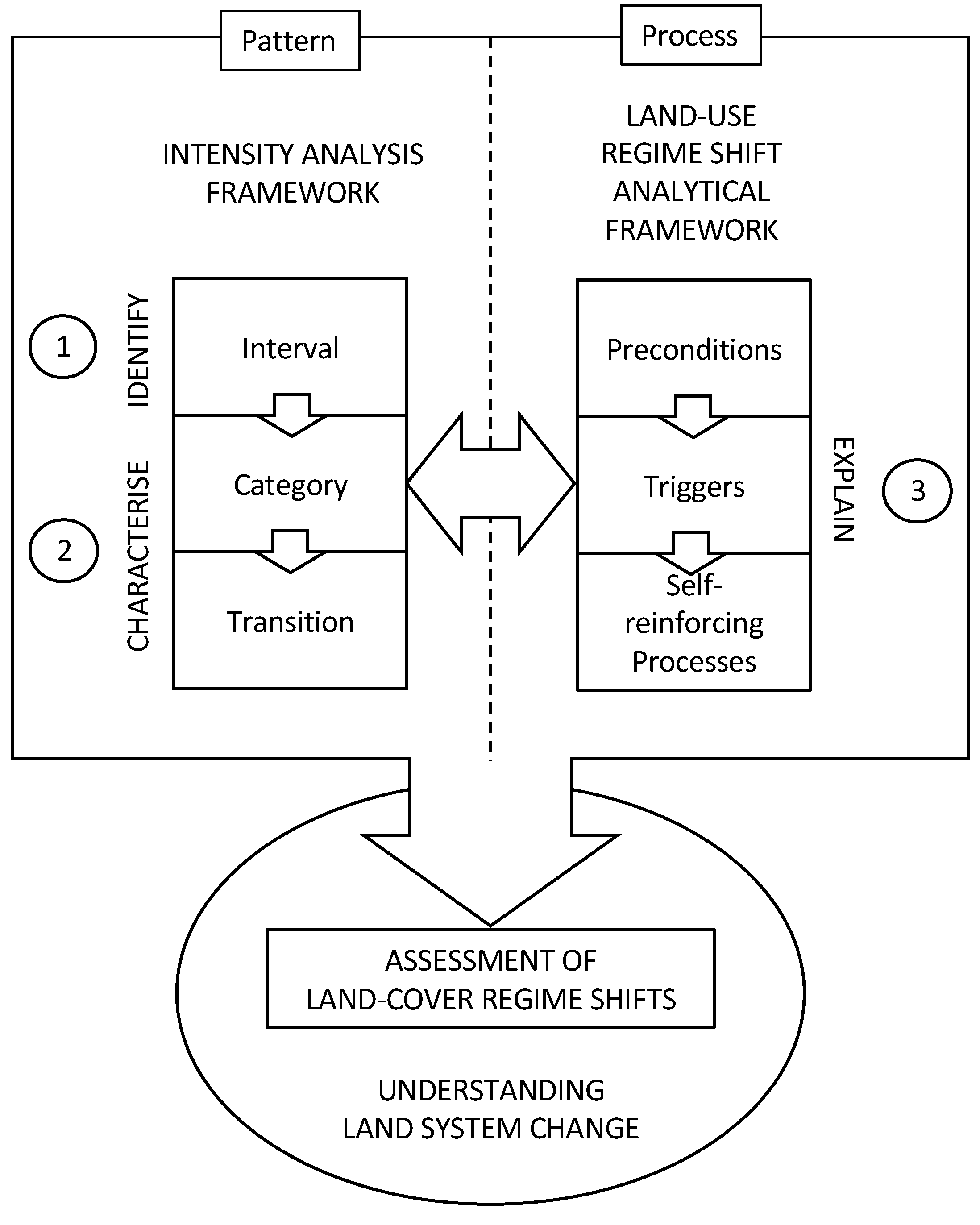
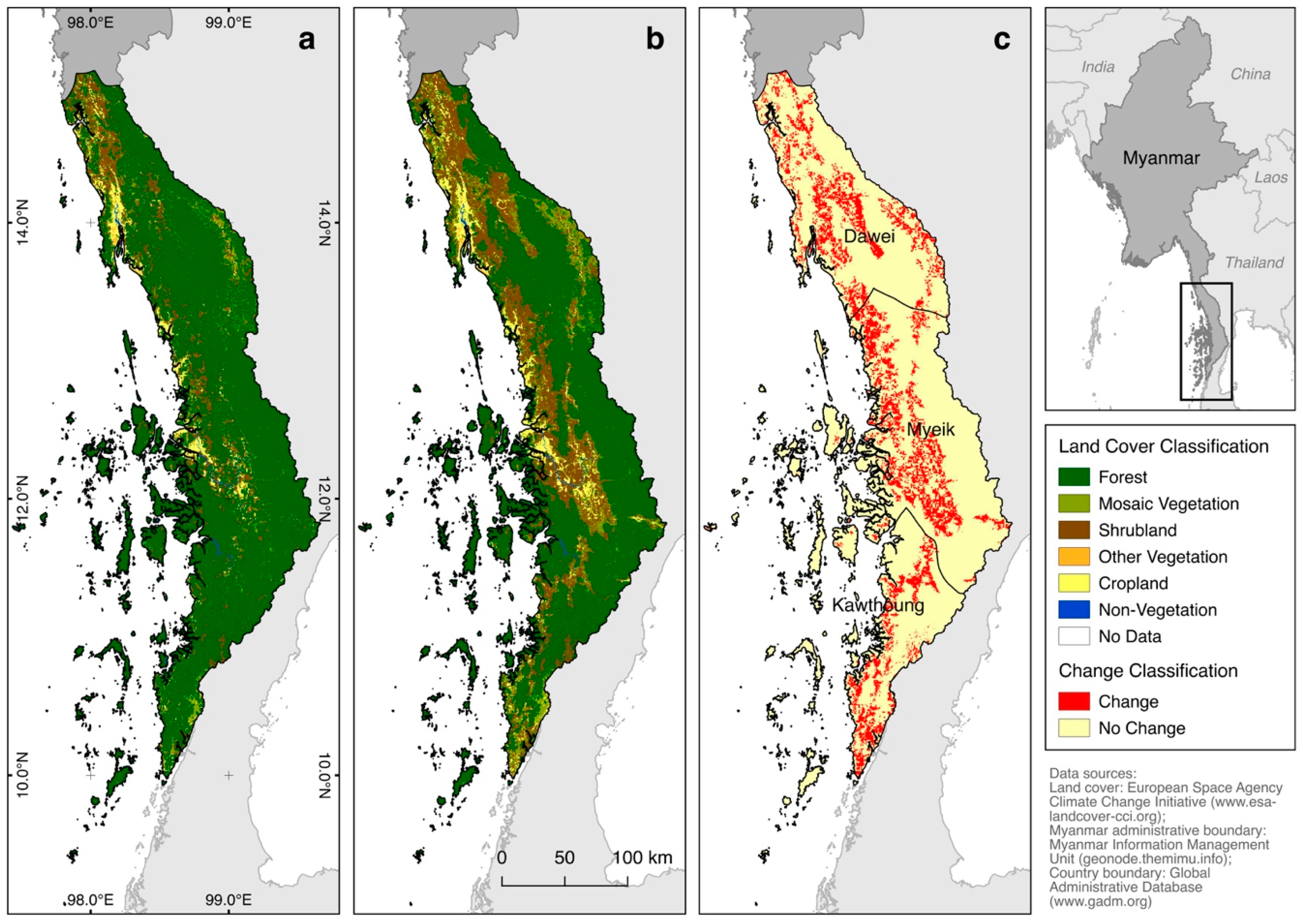
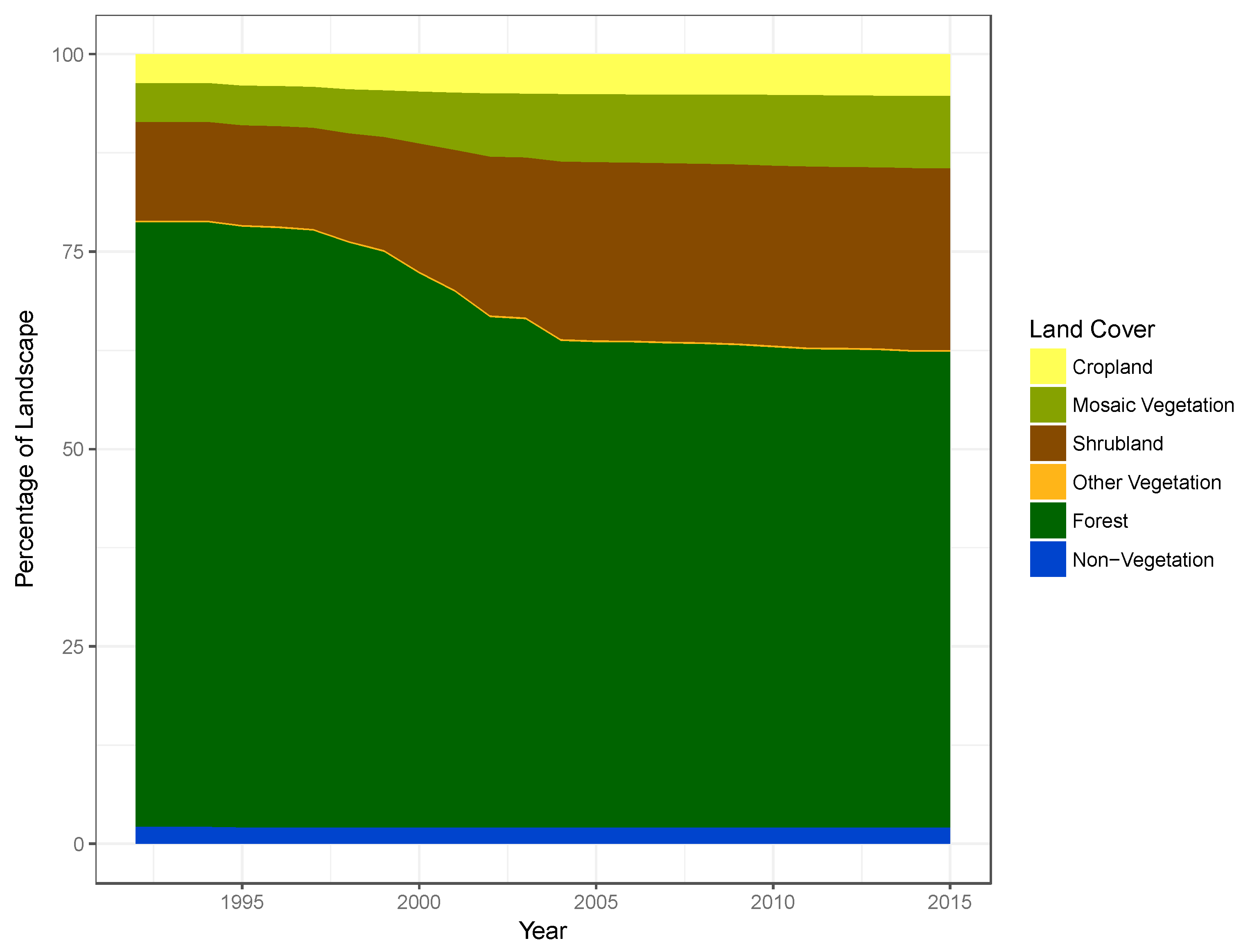
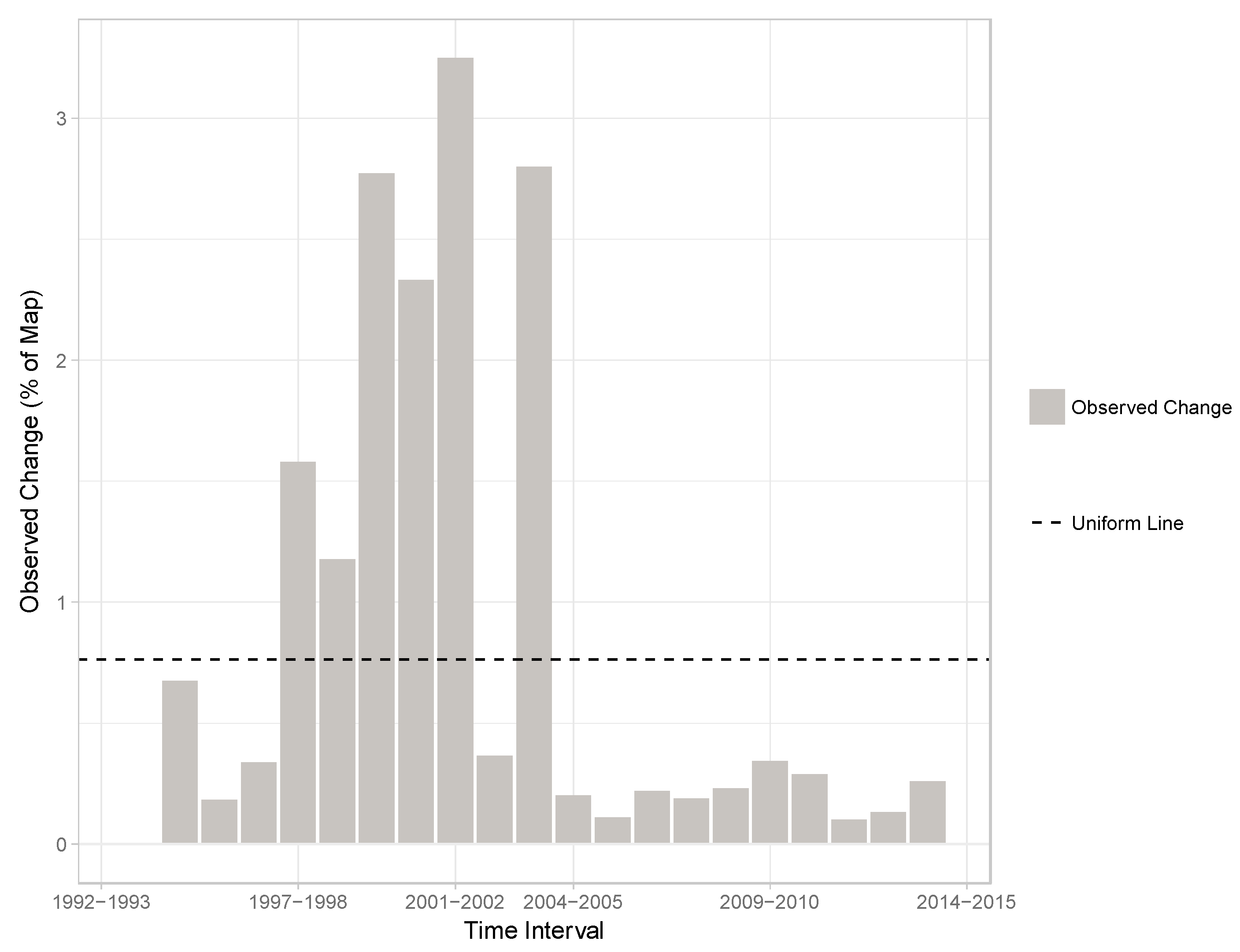
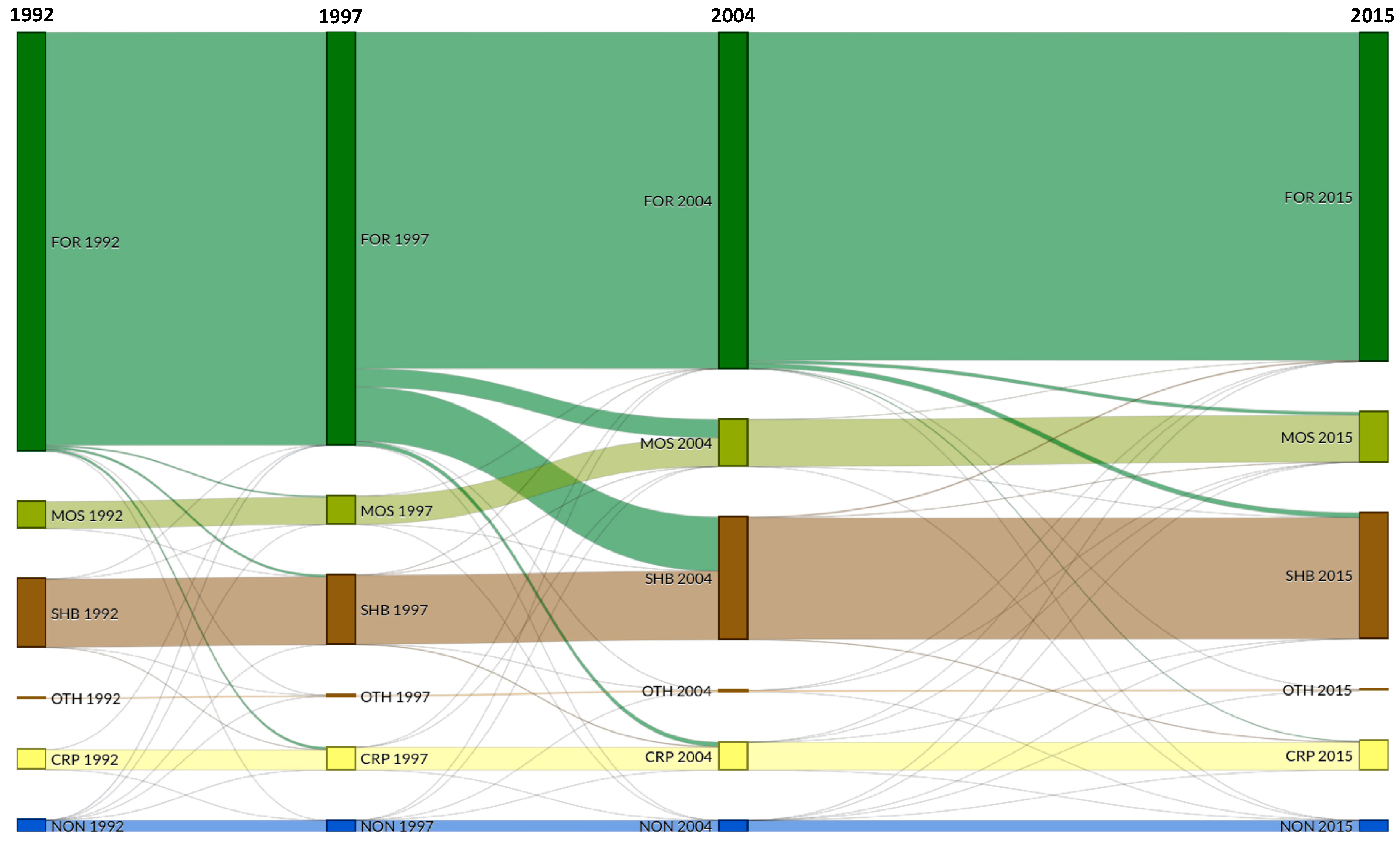
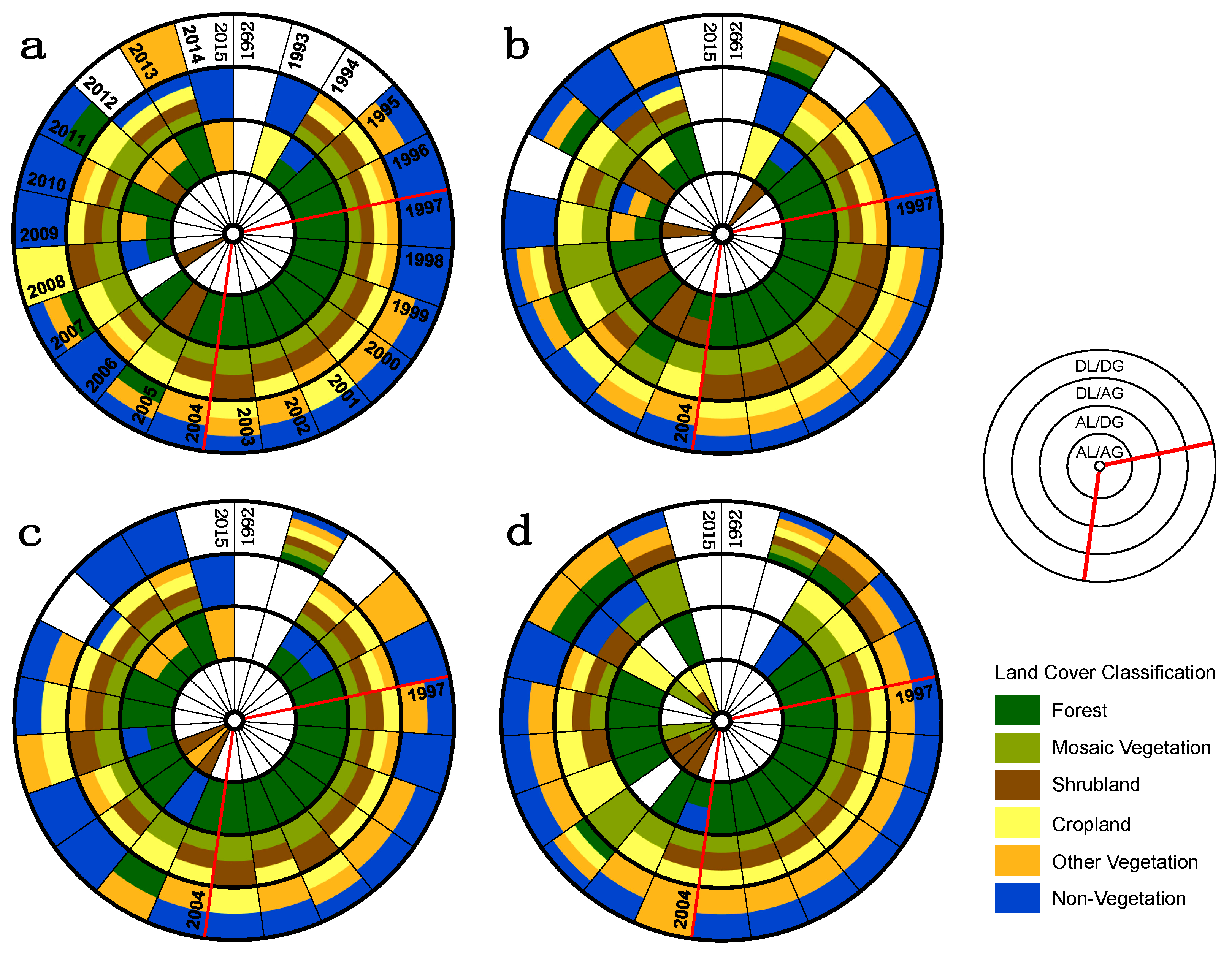
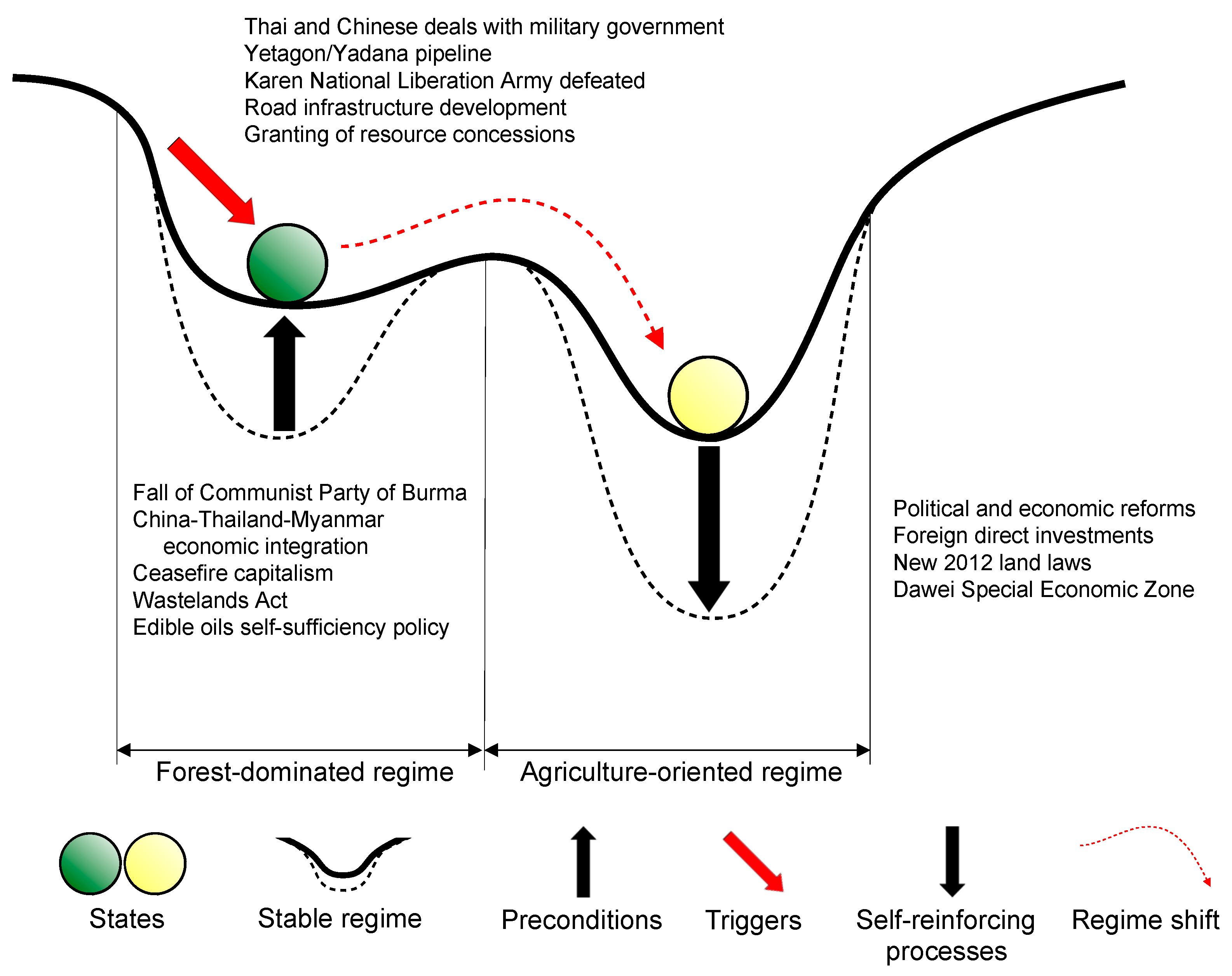
| Aggregated Category | Description |
|---|---|
| Forest | Tree cover (broadleaved or needleleaved; evergreen or deciduous; closed to open canopy; flooded saline water or flooded fresh/brackish water) |
| Mosaic Vegetation | Mosaic configuration of cultivated and managed terrestrial areas; natural and semi-natural terrestrial vegetation; and closed to open vegetation (trees, shrubs, herbaceous vegetation) |
| Shrubland | Broadleaved closed to open shrubland (thicket) |
| Cropland | Rainfed and irrigated crops (trees, shrubs, and herbaceous vegetation) |
| Other Vegetation | Includes grassland, sparse vegetation (trees, shrubs, and herbaceous cover) |
| Non-Vegetation | Includes urban areas and water bodies |
| Systematic Transition | |||
|---|---|---|---|
| Period | Interval | Targeted Forest | Avoided Forest |
| Pre-regime shift | 1995–1996 | Mosaic Vegetation Cropland | |
| 1996–1997 | Cropland Other Vegetation | Non-Vegetation | |
| Land-cover regime shift | 2000–2001 | Mosaic Vegetation | Cropland Other Vegetation |
| 2001–2002 | Shrubland | Non-Vegetation | |
| 2002–2003 | Non-Vegetation | ||
| 2003–2004 | Shrubland | ||
| Post-regime shift | 2004–2005 | Mosaic Vegetation | Non-Vegetation |
| 2005–2006 | Non-Vegetation | ||
| 2006–2007 | Shrubland Mosaic Vegetation Other Vegetation | Cropland Non-Vegetation | |
| 2007–2008 | Cropland Other Vegetation Non-Vegetation | ||
| 2008–2009 | Mosaic Vegetation | Non-Vegetation | |
| 2009–2010 | Mosaic Vegetation | Non-Vegetation | |
| 2010–2011 | Other Vegetation | Non-Vegetation | |
| 2011–2012 | Mosaic Vegetation | Cropland Non-Vegetation | |
| 2013–2014 | Shrubland | ||
© 2019 by the authors. Licensee MDPI, Basel, Switzerland. This article is an open access article distributed under the terms and conditions of the Creative Commons Attribution (CC BY) license (http://creativecommons.org/licenses/by/4.0/).
Share and Cite
De Alban, J.D.T.; Prescott, G.W.; Woods, K.M.; Jamaludin, J.; Latt, K.T.; Lim, C.L.; Maung, A.C.; Webb, E.L. Integrating Analytical Frameworks to Investigate Land-Cover Regime Shifts in Dynamic Landscapes. Sustainability 2019, 11, 1139. https://doi.org/10.3390/su11041139
De Alban JDT, Prescott GW, Woods KM, Jamaludin J, Latt KT, Lim CL, Maung AC, Webb EL. Integrating Analytical Frameworks to Investigate Land-Cover Regime Shifts in Dynamic Landscapes. Sustainability. 2019; 11(4):1139. https://doi.org/10.3390/su11041139
Chicago/Turabian StyleDe Alban, Jose Don T., Graham W. Prescott, Kevin M. Woods, Johanness Jamaludin, Kyaw Thinn Latt, Cheng Ling Lim, Aye Chan Maung, and Edward L. Webb. 2019. "Integrating Analytical Frameworks to Investigate Land-Cover Regime Shifts in Dynamic Landscapes" Sustainability 11, no. 4: 1139. https://doi.org/10.3390/su11041139
APA StyleDe Alban, J. D. T., Prescott, G. W., Woods, K. M., Jamaludin, J., Latt, K. T., Lim, C. L., Maung, A. C., & Webb, E. L. (2019). Integrating Analytical Frameworks to Investigate Land-Cover Regime Shifts in Dynamic Landscapes. Sustainability, 11(4), 1139. https://doi.org/10.3390/su11041139




